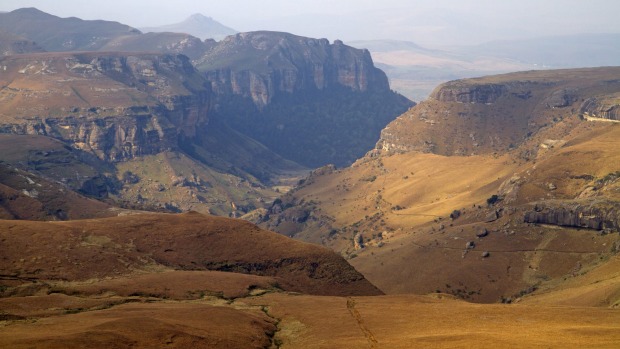
Stand at the base of South Africa's Drakensberg Mountains and it's easy to appreciate why the Zulu people called them the Barrier of Spears, and the Afrikaans pioneers named them the Dragon Mountains.
Rising out of the dry highveld, the range forms a serrated skyline of rock, with sharp-tipped peaks standing like pickets atop one of the world's longest and most spectacular escarpments.
Stretching for 300 kilometres through the east of the country, the Drakensberg are often overshadowed by the presence of Mt Kilimanjaro far to the north, but they offer the finest hiking in southern Africa.
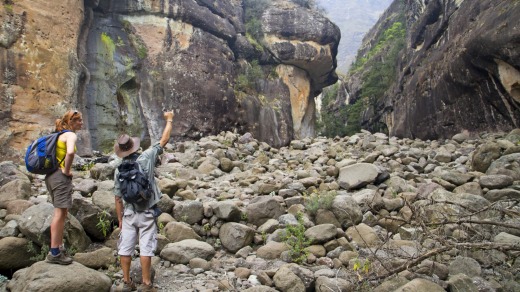
Walks can be as wild or mild as you choose, from an epic multi-day traverse once named by Outside magazine as one of the world's 10 most dangerous hikes, to simple day walks. At the foot of the escarpment, dwarfed by rock walls hundreds of metres high, I'm standing directly beneath the start of the traverse. I'm here for the day walks.
If the Drakensberg has one area that typifies its beauty, it's here in Royal Natal National Park. Protecting just a small piece of the vaster World Heritage-listed uKhahlamba Drakensberg Park, Royal Natal is split by the Amphitheatre, one of the most striking natural features in South Africa.
Shielded by an eight-kilometre-long wall of cliffs, it's claimed that the Amphitheatre's rock walls are three times larger in area than those on Yosemite's El Capitan, one of the world's most famous rock-climbing sites. Even those numbers aren't as impressive as the vision, though, as I stand at the entrance to the gorge, with a sheet of cliffs unfurling ahead of me.
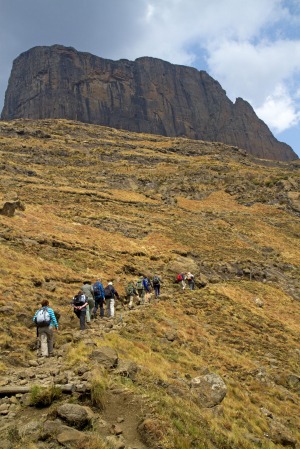
The Amphitheatre trail begins beside the almost-dry bed of the Tugela River, the longest river in KwaZulu Natal province. One bank is yellow with grass, and the other is green with regrowth after a recent fire.
The early walking is through open country, cutting across grassy slopes and occasionally turning into forested gullies. I've walked only minutes when a baboon strolls across the path, heading for the river, and snakes begin to criss-cross the trail.
Eroded pillars of sandstone protrude from the ridgeline above, and soon I'm inside an encirclement of cliffs, with mountains rising up to 1000 metres overhead. It's a fortress carved by nature, with Sentinel Peak and Eastern Buttress looking every bit like the spear tips of the Zulu name.
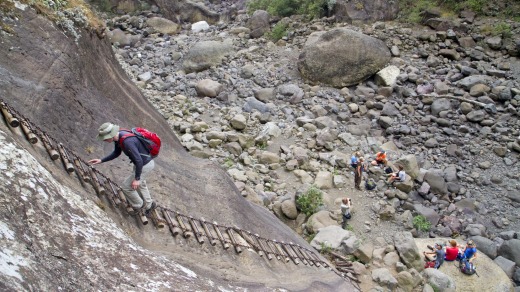
The Amphitheatre narrows as it approaches its end, with the trail seeming almost to sink into the gorge. Rock walls stained with ephemeral waterfalls now lean overhead, and it's as though I'm being swallowed by the "dragon".
At the gorge's end there's a confluence of two rivers, one rolling away through boulders and the other carving a slot through the cliffs. Though the trail has ended, I continue into the slot, hopping from rock to rock, jumping over pools of water that never see the sun and are icy to the touch. Stretch my arms wide and my fingertips almost brush against both walls of the slot.
By nightfall I'm no longer inside the Drakensberg, but outside looking in. Across the foot of the range, just outside the national park, is a string of accommodation, peering up at the mountains. I'm staying at Berghouse and Cottages, with its thatch-roofed, mud-brick cottages perched on a private hillside, peering across to the Amphitheatre and Sentinel Peak.
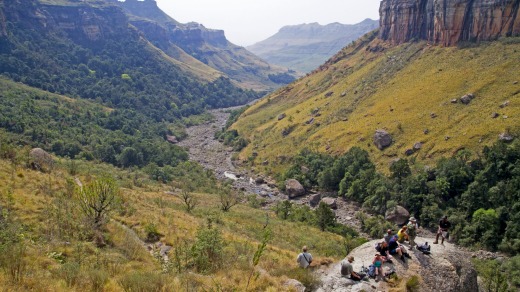
Various short walking and mountain biking trails radiate out from the cottages, and on dusk I wander out across the slopes, watching the sun roll away behind the Drakensberg.
Though the Drakensberg aren't noted for wildlife, it's still Africa. As I walk, just a few hundred metres from the cottages, two zebras stroll out of a gully. The previous week a leopard had been sighted across these very slopes - the only signs of it now are the quills of a dead porcupine strewn through the grass beside the path.
In the morning the sun rises weakly through gathering cloud, which creeps over the plateau to engulf Sentinel Peak. It's an inauspicious view, given that today we will be hiking around this very mountain.
The infamous Drakensberg Traverse begins at the Sentinel car park, high atop the range, but so too does another of the Drakensberg's finest day walks. This day we're angling for the head of Tugela Falls, the world's second-highest waterfall, spilling 948 metres from the Drakensberg plateau into the Amphitheatre.
From the car park the trail coils up to the base of 3165-metre-high Sentinel Peak. Within an hour, even the plateau has slipped far below us. Cloud hurries through and spokes of sunlight radiate from the sky. The view is blurred by moist, humid air, making the land swim in heat. It truly looks like Africa.
The Sentinel Trail doesn't ascend its namesake peak - this dark fin of rock is the preserve of climbers - but continues along the base of the escarpment. A fierce wind pins us to the rock, even as we pick through a section of trail covered in rubble from a landslide just three months before.
It's airy, heady walking, though safe and on a well-defined trail, but it's small shrift compared to things ahead. When Outside magazine selected the Drakensberg Traverse as one of its 10 most dangerous hikes on the planet, it wrote that the "most daunting part may be the beginning - two rickety chain ladders (that) take trekkers to the ridge". Soon, inside a notch in the escarpment, we are standing at the base of those very ladders.
The ladders drape down the cliffs like ponytails of steel, climbing 50 metres through the escarpment. They sit hard against the rock, providing stability, so that most of the danger is in the mind. Today, however, it's also complicated by weather.
Through the morning, 70 kilometre an hour winds have been scouring the Drakensberg Plateau and inside the notch; the wind is like a jet stream. We wait, but our hopes have blown away. The Barrier of Spears has repelled us.
www.zulu.org.za/discover/destinations/drakensberg
South African Airways . Fly Qantas to Perth and connect with South African Airways to Johannesburg. See www.flysaa.com.au. Australians can stay up to 90 days in South Africa visa-free.
Exodus Travels has a 15-day South African Walking Safari trip that begins in Johannesburg and includes day hikes in the Drakensberg Mountains. Trips begin at $2945. See www.exodus.co.uk.
Berghouse and Cottages has a selection of cottages with self-catering, B&B and dinner, bed and breakfast packages available. See www.berghouse.co.za. Atop the range, seven kilometres from the Sentinel car park, Witsieshoek Mountain Lodge is a basic, old-fashioned hotel, with bungalows and chalets, that's high on charm. See www.witsieshoek.co.za.
Popular five-day trek through the southern Drakensberg, beginning at Sano Pass and finishing at Bushman's Nek. Popular, and requires advance booking through Ezemvelo KZN Wildlife.
One of the country's most popular and famous hikes, covering around 42 kilometres (five days) of coastal beauty in the Eastern Cape's Tsitsikamma National Park.
The ultimate Cape Town hike, this two-day walk circuits the southern tip of the cape, taking in Cape Point and the False Bay and Atlantic coasts.
Join a three-day hike through Kruger National Park. The park has seven guided Wilderness Trails, hiking with armed guides.
Tough walking through the Amathole Mountains of Eastern Cape, with good swimming holes as reward. Accommodation is in basic huts.